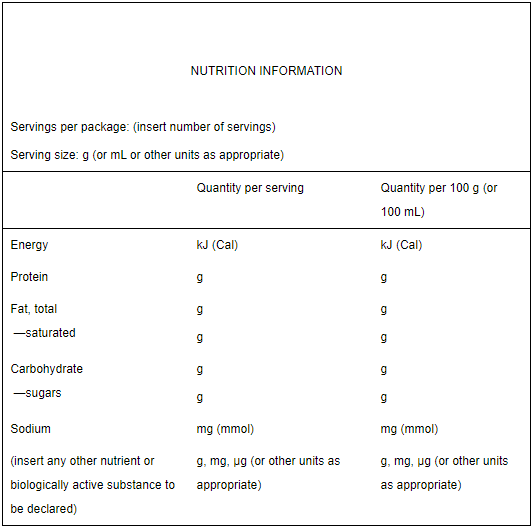Here you'll find frequently asked questions about the Nutrition Panel Calculator (NPC) and how to create Nutrition Information Panels (NIP).
On this page
- What are the requirements for an NIP?
- What do I do if I can't find my ingredient in the NPC database?
- Where can I find information on the foods in the NPC database?
- Where can I find information on the nutrients reported in the NPC?
- Who should I contact?
What are the requirements for an Nutrition Information Panel?
Standard 1.2.8 Nutrition Information Requirements of the Food Standards Code requires most packaged foods to display a NIP on its label. The NIP must show the average quantities of:
- energy in kilojoules
- protein
- fat
- saturated fat
- carbohydrate
- sugars
- sodium.
The NIP must also show the food and serving in both 100 g, or 100 mL. Clause 5 of Standard 1.2.8 sets out what the NIP must include as well as a specific format. An example of a basic nutrition information panel is provided below.

Significant figures
Clause 6(1) of Standard 1.2.8 requires the energy and nutrient values in an NIP must be no more than three significant figures.
A significant figure is the digits in a number excluding the zeros after an integral number or before a decimal fraction. For example both 0.0392 and 352000 have three significant figures.
The rules for rounding to three significant figures used by the NPC are:
- If the 4th significant figure is in the range 1 to 4, the 3rd significant figure is unchanged, example 21.22 is rounded to 21.2, or 1142 is rounded to 1140, or 105.1 is rounded to 105.
- If the 4th significant figure is in the range 6 to 9, the 3rd significant figure is rounded up, example 21.26 is rounded up to 21.3, or 1147 is rounded up to 1150.
- If the 4th significant figure is 5, rounding occurs like this:
- If the 3rd significant figure is an even number it remains unchanged example 21.25 is rounded to 21.2, or 1145 is rounded to 1140.
- If the 3rd significant figure is an odd number, it is rounded up example 21.35 is rounded up to 21.4, or 1155 is rounded up to 1160.
More information about significant figures and rounding of values containing more than three significant figures is in the user guide that accompanies Standard 1.2.8.
Number of decimal places
There are conventions to the number of decimal places used to present data in Australian food composition databases. They ensure we don't assign a level of precision to the data that is unjustified, given its nature.
For values less than 100 g, round the following to 1 decimal place:
- protein
- fat
- saturated fat
- carbohydrate and sugars.
For example 99.9, 5.2 and 0.3. Do this even if that means there are less than 3 significant figures reported.
For energy and sodium, never use decimal places. Even if the energy or sodium value is a single digit. For example:
- an energy value of 98.1 kJ is reported as 98 kJ
- a sodium value of 17.5 mg is reported as 18 mg
- a sodium value of 8.25 mg is reported as 8 mg.
What do I do if I can't find my ingredient in the NPC dataset?
The NPC database contains the most up to date and relevant data available at the time of release. You can find information on the foods in the database on the Foods in the NPC page.
If your ingredient isn't available in the NPC database, you can:
- Have the nutrient content of your food determined by laboratory analysis. We strongly recommend that you make use of this option wherever possible.
- Try obtaining nutrient data from your ingredient supplier or from other food composition data sources such as research papers and international databases. While food industry ingredients are unlikely to be in national food composition databases, household ingredients may be. You can then add the ingredient data as a custom ingredient and use them in your NIP calculations. Details of this function is available in the Creating custom ingredients section of the Full user guide.
The final decision on how to source data for ingredients is up to you. Remember, some food additives and processing ingredients, in small quantities, may have a small impact on the final NIP values. This is with the exception of food additives containing sodium.
If you get data from other sources, it's up to you to decide if the data is appropriate for your NIP. You need to assess if the data meets Standard 1.2.8 Nutrition Information Requirements of the Code.
Where can I find information on the foods in the NPC database?
The NPC has a database of foods which can be used as ingredients in your recipes. Information of the database and how the foods are reported is available on the Foods in the NPC page.
Where can I find information on the nutrients reported in the NPC?
The NPC reports data for the seven mandatory components of an NIP:
- energy
- protein
- total fat
- saturated fat
- total carbohydrate
- total sugar
- sodium.
Information on these components and how the data has been compiled in the NPC database is available on the Nutrients in the NPC page.
Who should I contact?
If you have questions, please email the NPC team. You can find their email on the Contact us page.
